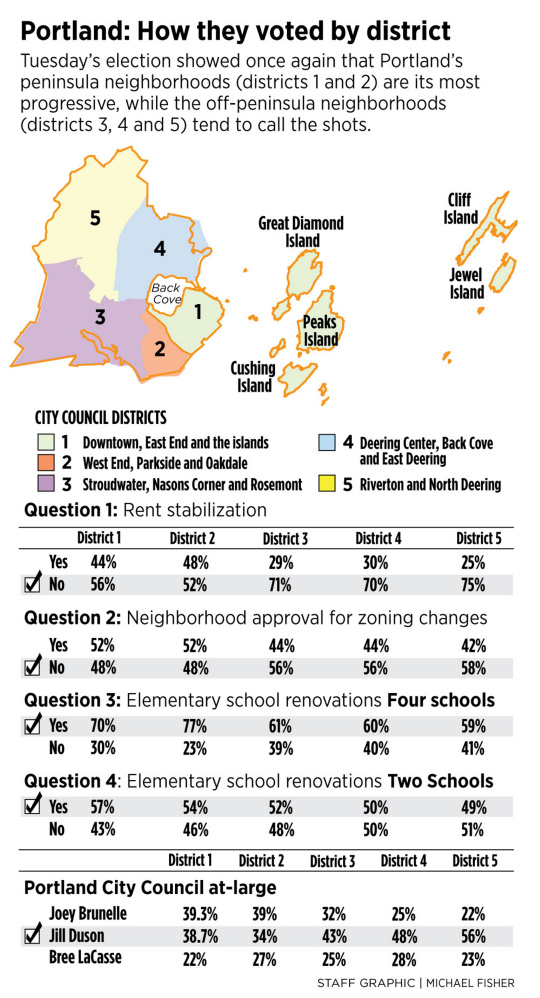Portland’s peninsula may be the toast of the town with its restaurants, hotels, art galleries and young political activists. But, when it comes to deciding elections, it’s often the city’s outlying neighborhoods, anchored by older residents and families, that call the shots.
And Tuesday’s election was no different.
Once again, off-peninsula residents of Deering – north, central and east – led the way in defeating citizen referendums and council candidates who ran as progressives, but who joined peninsula residents to pass a $64 million bond to renovate four elementary schools.
With the exception of the school bond that was supported citywide, peninsula residents were outmatched by their off-peninsula counterparts, who account for nearly 60 percent of the city’s registered voters and typically turn out to vote in higher numbers on citywide issues. On Tuesday, off-peninsula precincts reported a 32 percent turnout, while on-peninsula precincts reported a 28 percent turnout. Those numbers don’t include absentee ballots.
Off-peninsula voters tend to be more conservative, at least by standards of Portland, where half of the 56,205 registered voters are Democrats, 32 percent are unenrolled, 12 percent are Republican and 5 percent are Green Independent.
Democrats make up 48 percent of the off-peninsula electorate, while Republicans account for 16 percent.
On-peninsula voters are generally younger and more liberal, with 51 percent of voters in those five precincts registered Democrats and 6 percent greens, while only 8 percent are Republicans.
Brit Vitalius, president of the Southern Maine Landlord Association and spokesperson for Say No To Rent Control, which opposed Portland’s Question 1, said the group deliberately targeted off-peninsula districts with mailers and canvasing.
“We were told to give up on the peninsula,” Vitalius said.
The tempering of Portland’s most progressive impulses is a dynamic that was also at-play in the 2015 election, when off-peninsula voters largely defeated a proposed $15 an hour minimum wage and a scenic-view protection initiative.
This year, voters on the peninsula wanted to pass Question 2 on the city ballot, which would have allowed neighbors of development proposals to stop the City Council from making zone changes. But off-peninsula, voters weren’t interested in the new rules, so they were defeated.
Residents were even opposed in Stroudwater, an off-peninsula neighborhood in the western part of the city where the rezoning proposal was born out of frustration over the council’s decision to rezone more than 45 acres of land, known as Camelot Farm, for a housing development.
Fifty-two percent of the 6,325 ballots cast on the peninsula were in support of the measure, which would have allowed residents to block any zone change by a developer if 25 percent of the people living within 500 feet opposed it. Off-peninsula, however, 57 percent of the 10,426 votes cast were in opposition and the measure was defeated.
Heather Sanborn, a spokeswoman for One Portland, which opposed the proposal, said the group didn’t target any geographical areas of the city. Instead, it focused on likely voters, who generally tend to live off-peninsula. She was surprised to see District 3, which includes Camelot Farm, vote against the proposal.
“We were aware that it would be important to make sure our message got out to as many people who were going to vote as possible,” Sanborn said. “We were heartened by the results in District 3.”
The differences also played a role in the rent-control vote, but in less predictable ways.
Despite the fact that nearly 60 percent of Portland residents are renters and about half of those rental units are on the peninsula, 54 percent of voters there voted against it. Voters on Munjoy Hill and the West End led the opposition, while renters in Bayside, Parkside and St. John Valley neighborhoods, as well as the downtown district, supported it.
Perhaps most surprising was Munjoy Hill, an area where many residents are concerned about gentrification and soaring rents. Sixty percent of those voters said ‘no’ to rent control, while 55 percent of West End voters opposed it.
Of course, off-peninsula voters came out in a big way to put a decisive nail in the rent-control coffin, with 72 percent of the 10,643 ballots cast being in opposition.
The on-peninsula versus off peninsula dynamic was also at play in the three-way at large council race.
Council candidate Joey Brunelle, who supported rent control and was inspired to run for office by Sen. Bernie Sanders, won four of five voting precincts downtown, getting 30 percent of the vote there.
But Jill Duson, a 16-year incumbent, cruised to victory by collecting 49 percent of the off-peninsula vote and winning in all of six off-peninsula precincts. She ended up getting 44 percent of the vote citywide, including a first-place finish on Munjoy Hill, where she beat Brunelle by 15 votes.
The third at-large candidate, Bree LaCasse, who raised the most money in the council race with over $50,000, placed third in all but three precincts. An eventual opponent of rent control, LaCasse placed second in three polling locations off-peninsula, which is represented by state Sen. Mark Dion, a prominent LaCasse supporter.
Randy Billings can be reached at 791-6346 or at:
rbillings@pressherald.com
Twitter: randybillings
Send questions/comments to the editors.




